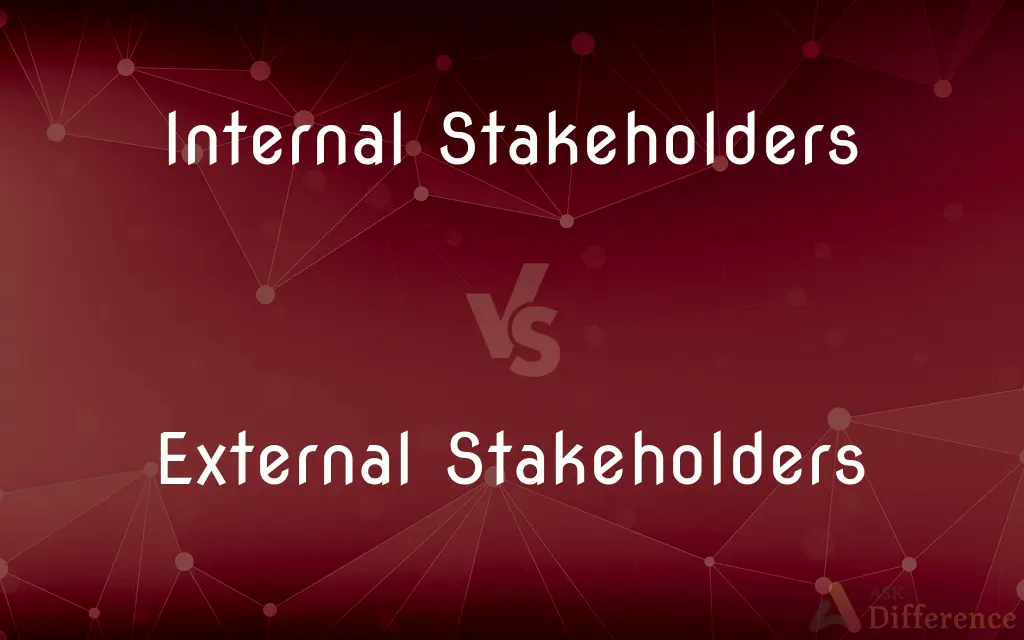Internal Stakeholders vs. External Stakeholders — What's the Difference?
By Tayyaba Rehman — Published on October 1, 2023
Internal Stakeholders are individuals or groups within an organization, like employees, while External Stakeholders are outside entities, such as customers, that have an interest in the organization’s activities.

Difference Between Internal Stakeholders and External Stakeholders
Table of Contents
ADVERTISEMENT
Key Differences
Internal Stakeholders and External Stakeholders are integral entities impacting an organization's operations, strategy, and outcomes. Internal Stakeholders typically include individuals or groups within an organization, such as employees, managers, and owners, who are directly involved in the organization's decision-making processes. They often have a significant influence on the organization's policies, objectives, and operational procedures, aligning their interests and contributions with the organization's goals and values.
In contrast, External Stakeholders are entities outside the organizational structure, like customers, suppliers, creditors, and the community, who have an interest or stake in the organization’s activities and outcomes. They can influence or be influenced by the organization’s decisions, actions, and objectives. While their involvement in decision-making processes might be indirect, their perspectives, needs, and expectations are crucial for the organization’s sustainability and success.
Recognizing the interests and influences of Internal Stakeholders is crucial as it fosters a sense of ownership and alignment with the organizational goals, enhancing productivity and morale. Their insights, commitment, and capabilities are essential for driving innovation, improvement, and performance within the organization. Addressing their concerns and aspirations is pivotal for maintaining harmony and motivation in the organizational environment.
Conversely, acknowledging and addressing the concerns and expectations of External Stakeholders is vital for building trust, reputation, and mutually beneficial relationships. Their feedback and support can offer valuable insights, resources, and opportunities, contributing to the organization’s development, adaptability, and resilience in the dynamic external environment.
Balancing the interests and influences of both Internal and External Stakeholders is essential for organizational synergy and equilibrium. While Internal Stakeholders contribute to the organization's internal dynamics and functionalities, External Stakeholders shape its external interactions and perceptions. Harmonizing these diverse and sometimes conflicting interests is key for achieving organizational coherence, responsiveness, and prosperity.
ADVERTISEMENT
Comparison Chart
Definition
Individuals or groups within an organization.
Entities outside the organizational structure.
Involvement
Directly involved in decision-making processes.
Influence or are influenced by the organization’s actions.
Interest
Have a significant interest in organizational activities.
Have a stake in the organization’s outcomes.
Influence
Shape organizational policies, objectives, and procedures.
Impact organization’s reputation and sustainability.
Contribution
Enhance productivity and innovation within the organization.
Offer valuable insights, resources, and opportunities.
Compare with Definitions
Internal Stakeholders
Internal Stakeholders are individuals or groups within an organization.
Internal Stakeholders, like employees and managers, actively participate in organizational decision-making processes.
External Stakeholders
External Stakeholders can influence or be influenced by organizational decisions.
The feedback from External Stakeholders is pivotal for refining organizational strategies and offerings.
Internal Stakeholders
Internal Stakeholders align their interests with organizational goals.
By addressing the concerns of Internal Stakeholders, organizations can foster alignment and commitment.
External Stakeholders
External Stakeholders shape organizational interactions and perceptions.
The perceptions and expectations of External Stakeholders shape how the organization is viewed and interacted with in the external environment.
Internal Stakeholders
Internal Stakeholders have significant influence over organizational policies.
The preferences and viewpoints of Internal Stakeholders often shape the formulation of organizational policies and strategies.
External Stakeholders
External Stakeholders offer valuable insights and resources.
The support and resources from External Stakeholders can enhance the organization’s adaptability and resilience.
Internal Stakeholders
Internal Stakeholders have a direct impact on organizational outcomes.
The insights and contributions of Internal Stakeholders are crucial for achieving organizational objectives.
External Stakeholders
External Stakeholders are entities outside the organizational structure.
External Stakeholders, such as customers and suppliers, have interests in the organization’s activities and performance.
Internal Stakeholders
Internal Stakeholders contribute to organizational innovation and improvement.
The involvement of Internal Stakeholders in brainstorming and discussions fosters innovation and continuous improvement.
External Stakeholders
External Stakeholders impact the organization’s reputation and sustainability.
Maintaining positive relationships with External Stakeholders is crucial for building trust and reputation in the market.
Common Curiosities
Do External Stakeholders have a direct involvement in organizational decisions?
Typically, External Stakeholders do not have direct involvement but can influence or be influenced by organizational decisions.
Do Internal Stakeholders contribute to organizational innovation?
Yes, the insights and contributions of Internal Stakeholders are crucial for fostering innovation within the organization.
Who are considered Internal Stakeholders?
Internal Stakeholders are individuals or groups within an organization, such as employees, managers, and owners.
Can External Stakeholders impact an organization’s reputation?
Yes, the perceptions and interactions of External Stakeholders can significantly impact an organization’s reputation and sustainability.
Are the interests of Internal Stakeholders aligned with organizational goals?
Yes, Internal Stakeholders typically align their interests and contributions with the organizational goals and values.
How do Internal Stakeholders influence organizational policies?
Their preferences, insights, and viewpoints often play a significant role in shaping and formulating organizational policies and strategies.
Is addressing the concerns of Internal Stakeholders important for organizations?
Absolutely, addressing their concerns is pivotal for maintaining harmony, motivation, and alignment within the organization.
How do External Stakeholders offer value to organizations?
They offer valuable insights, feedback, resources, and support, contributing to the organization’s development and adaptability.
How do organizations benefit from maintaining positive relationships with External Stakeholders?
Positive relationships with External Stakeholders build trust, reputation, and mutually beneficial collaborations, enhancing organizational success.
Share Your Discovery

Previous Comparison
Parents vs. Guardians
Next Comparison
Managerial Employees vs. Non Managerial EmployeesAuthor Spotlight
Written by
Tayyaba RehmanTayyaba Rehman is a distinguished writer, currently serving as a primary contributor to askdifference.com. As a researcher in semantics and etymology, Tayyaba's passion for the complexity of languages and their distinctions has found a perfect home on the platform. Tayyaba delves into the intricacies of language, distinguishing between commonly confused words and phrases, thereby providing clarity for readers worldwide.
















































